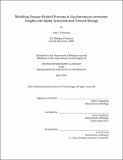| dc.contributor.advisor | Susan Lindquist. | en_US |
| dc.contributor.author | Valastyan, Julie S. (Julie Suzanne) | en_US |
| dc.contributor.other | Massachusetts Institute of Technology. Department of Biology. | en_US |
| dc.date.accessioned | 2013-09-24T19:35:02Z | |
| dc.date.available | 2013-09-24T19:35:02Z | |
| dc.date.copyright | 2013 | en_US |
| dc.date.issued | 2013 | en_US |
| dc.identifier.uri | http://hdl.handle.net/1721.1/80984 | |
| dc.description | Thesis (Ph. D.)--Massachusetts Institute of Technology, Dept. of Biology, 2013. | en_US |
| dc.description | Cataloged from PDF version of thesis. Vita. | en_US |
| dc.description | Includes bibliographical references. | en_US |
| dc.description.abstract | The yeast Saccharomyces cerevisiae has long been used to model complex cellular processes. As a eukaryote, much of its fundamental biology is conserved with higher organisms. As a single-celled, genetically tractable organism, it can easily be utilized for both high-throughput screening and hypothesis-driven analysis. Therefore, many groups use yeast to model disease-related proteins. One such model utilizes heterologous expression of [alpha]-synuclein ([alpha]-syn), a protein implicated in the progression of Parkinson's disease and other synucleinopathies. [alpha]-Syn expression in yeast is associated with many phenotypes that are recapitulated in higher organisms. Here, I used yeast to characterize two naturally occurring splice isoforms of [alpha]-syn, [alpha]-syn[delta]4 and [alpha]-syn[delta]6. Levels of these isoforms vary between synucleinopathies but little is known about their biology. I found that these splice isoforms display different localization patterns than full-length [alpha]-syn ([alpha]-synFL) and are less toxic in yeast. However, when expressed at a high level, both splice isoforms can exert toxicity and affect similar processes to [alpha]-synFL. Interestingly, the splice isoforms show differential responses to perturbations in sterol homeostasis. Studies concerning the relationship between sterol levels and synucleinopathy progression have been contradictory. Our findings reveal that [alpha]-syn[delta]4 is less sensitive to changes in sterol levels than [alpha]-synFL and [alpha]-syn[delta]6, suggesting that change in [alpha]-syn splice isoforms levels is a potential mechanism for these conflicting results. I also describe an attempt to model torsinA pathobiology in yeast. Mutations in torsinA cause early onset torsion dystonia, a devastating motor disorder. This protein has been described to function in regulating endoplasmic reticulum (ER) stress through the unfolded protein response (UPR). While I was unable to recapitulate a role for torsinA in the UPR in yeast, this model can serve as a platform for discovery of torsinA cofactors that enable it to act in this capacity, especially as more is uncovered concerning torsinA's role in the UPR. This thesis highlights both the strengths and limitations of modeling disease proteins in yeast. More specifically, my success with [alpha]-syn splice isoforms may provide insight into synucleinopathy etiology, while my inability to model torsinA-induced toxicity can inform subsequent attempts to study disease related proteins in yeast. | en_US |
| dc.description.statementofresponsibility | by Julie S. Valastyan. | en_US |
| dc.format.extent | 143 p. | en_US |
| dc.language.iso | eng | en_US |
| dc.publisher | Massachusetts Institute of Technology | en_US |
| dc.rights | M.I.T. theses are protected by
copyright. They may be viewed from this source for any purpose, but
reproduction or distribution in any format is prohibited without written
permission. See provided URL for inquiries about permission. | en_US |
| dc.rights.uri | http://dspace.mit.edu/handle/1721.1/7582 | en_US |
| dc.subject | Biology. | en_US |
| dc.title | Modeling disease-related proteins in Saccharomyces cerevisiae : insights into alpha-synuclein and TorsinA biology | en_US |
| dc.title.alternative | Insights into alpha-synuclein and TorsinA biology | en_US |
| dc.type | Thesis | en_US |
| dc.description.degree | Ph.D. | en_US |
| dc.contributor.department | Massachusetts Institute of Technology. Department of Biology | |
| dc.identifier.oclc | 857788408 | en_US |
